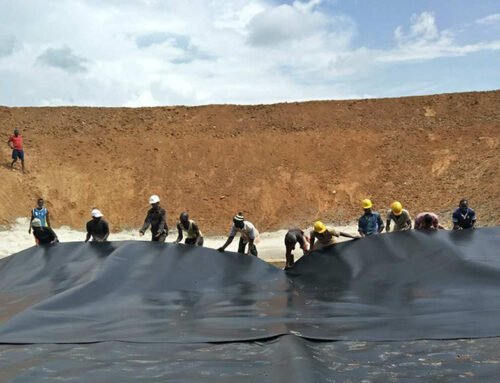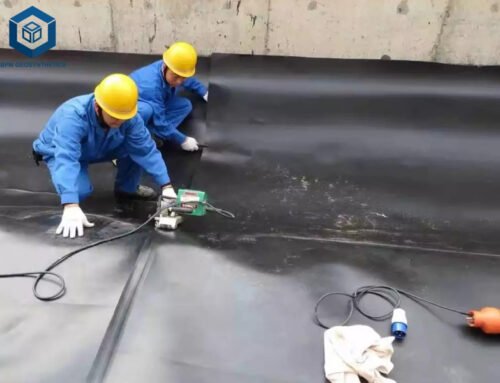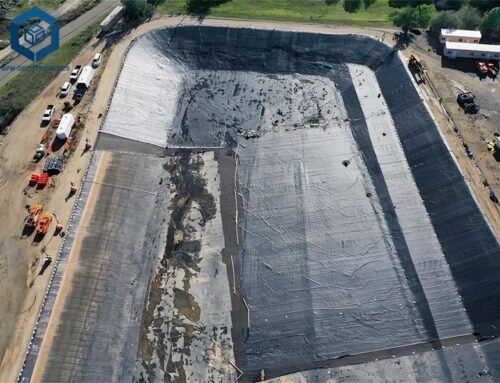HDPE membrane, also known as HDPE Geomembrane, is the type of geomembrane liner widely used in engineering and construction fields. HDPE membrane liners are the excellent choice for lining projects due to their outstanding mechanical and chemical properties, providing long-term environmental protection. They are highly resistant to various solvents and are globally recognized as the most widely used geomembrane liners. HDPE membranes find extensive applications in waste containment, liquid containment, aquaculture, agriculture, mining, and more.
As the professional geomembrane manufacturer and supplier, BPM Geomembrane offers high quality HDPE geomembrane with custom size and thickness at best factory price. In this article, will delve into the definition, characteristics, application range and construction advantages of HDPE membrane.
1. What Is A HDPE membrane
An HDPE membrane is a geosynthetic material composed of high-density polyethylene (HDPE) that finds wide application in engineering construction for anti-seepage, waterproofing, and soil protection purposes. It has gained popularity as a preferred choice for waterproofing projects due to its numerous advantages over other materials. HDPE membrane offers exceptional durability, flexibility, and resistance to root penetration. Additionally, its installation process is relatively fast and straightforward, making it suitable for a variety of projects.
HDPE membrane is a type of geomembrane extensively used in civil engineering and environmental applications. It is a synthetic membrane manufactured from high-density polyethylene polymers, which contribute to its excellent mechanical properties, chemical resistance, and long-lasting performance. The manufacturing process typically involves extrusion, resulting in sheets of varying thicknesses.
The thickness of HDPE geomembrane can range from 20 mils to 120 mils, providing flexibility in selecting the appropriate thickness based on the specific requirements of the project. Thicker membranes offer increased resistance to punctures and provide enhanced protection against potential seepage.
With its superior properties and versatility, HDPE membrane serves as a reliable solution for preventing water seepage and ensuring the integrity of structures in a wide range of construction projects.
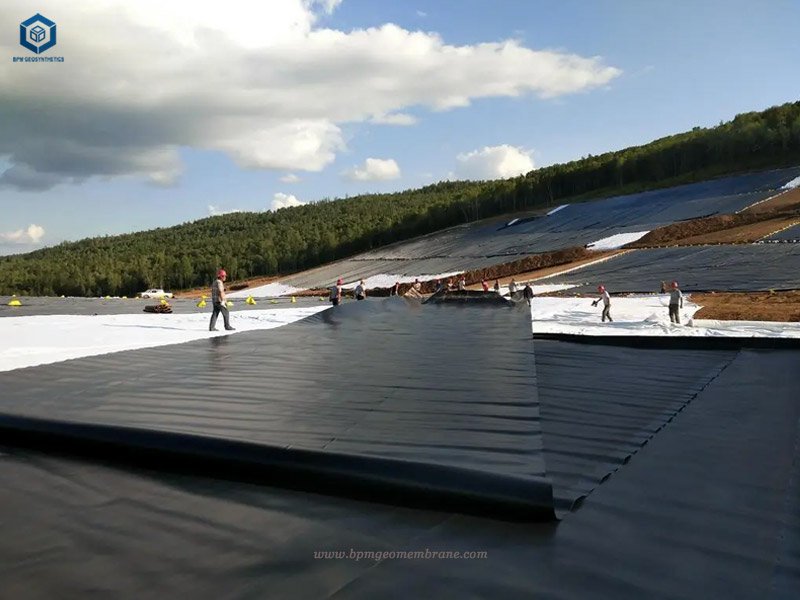
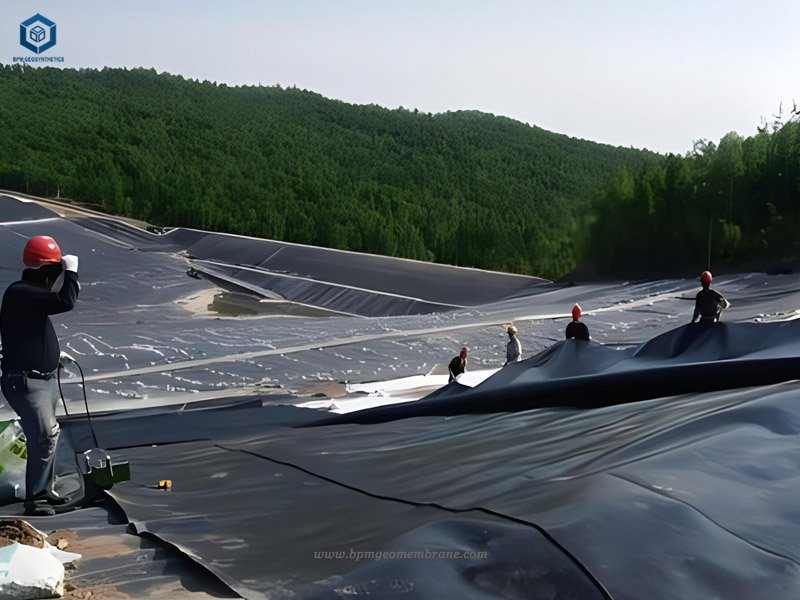
2. What Are The Features of HDPE Membrane?
The features of HDPE membrane encompass various characteristics that contribute to its effectiveness and suitability for different applications.
2.1 High-density polyethylene (HDPE)
HDPE is a type of polyethylene known for its high molecular structure, resulting in tightly arranged polymer chains. This structure grants HDPE geomembrane exceptional physical strength and durability, enhancing its overall performance.
2.2 Anti-seepage properties
Excellent waterproof performance: HDPE membrane exhibits excellent waterproofing capabilities, effectively preventing the penetration of moisture and chemicals into soils or structures. This feature is crucial for applications where preventing seepage is a primary concern.
Suitability for different geological conditions: HDPE geomembrane’s high resistance to chemical corrosion enables its use in diverse geological conditions, including acidic or alkaline soils. It remains stable and effective even in challenging environmental conditions.
2.3 Physical properties
High strength and tear resistance: HDPE membrane possesses impressive tensile strength and tear resistance, allowing it to withstand external pressure and resist damage. This characteristic ensures its longevity and reliability in demanding applications.
b. Flexibility: Despite its strength, HDPE membrane retains flexibility, enabling it to conform to various shapes and terrains. This adaptability facilitates easier installation and ensures effective coverage of irregular surfaces.
2.4 Aging UV and oxidation Resistance
HDPE membrane exhibits remarkable resistance to aging caused by UV rays and oxidation. It can withstand long-term exposure to sunlight and natural environments while maintaining its performance and integrity.
HDPE membrane is the highly desirable choice for a wide range of applications, including anti-seepage, waterproofing, and soil protection in civil engineering and environmental projects. The material’s durability, anti-seepage properties, physical strength, flexibility, and aging resistance contribute to its effectiveness and longevity, ensuring reliable performance in challenging conditions.
3. What Are Application Fields of HDPE Membrane?
HDPE membrane is suitable for many engineering fields due to its excellent anti-seepage and waterproof properties, providing reliable soil protection and anti-seepage solutions for various projects.
3.1 Water conservancy project
Reservoirs and dams: HDPE membrane can be used as the anti-seepage layer of reservoirs and dams to effectively prevent water penetration and ensure the stability of water bodies.
Rivers and canals: In the repair and construction of rivers and canals, HDPE membranes can be used to prevent water penetration and protect the soil structure.
3.2 Urban infrastructure construction
Basement waterproofing: HDPE geomembrane is often used as a waterproof layer in building basements to prevent groundwater penetration and ensure the stability of the building structure.
Tunnel engineering: In tunnel construction, HDPE membrane serves as an anti-seepage layer to prevent the impact of groundwater on the tunnel structure.
3.3 Landfill
Anti-seepage layer: HDPE membrane is widely used in landfills as an anti-seepage layer to effectively prevent wastewater from penetrating and preventing groundwater from being polluted.
Covering layer: In the final covering layer of the landfill, HDPE membrane can be used to prevent rainwater penetration and reduce waste discharge.
3.4 Mining anti-seepage
Tailings dam: HDPE geomembrane can be used as the anti-seepage layer of tailings dams to ensure that the slag will not have a harmful impact on the surrounding environment.
Acidic slag treatment: For acidic slag, HDPE geomembrane can prevent harmful substances from penetrating into the soil.
4. What Are Advantages of HDPE Membrane?
- Simple construction: as long as the pond is dug and leveled accordingly, there is no need to lay a concrete cushion;
- Fast construction: there is no solidification period required for structural concrete;
- Resistance to foundation deformation: Because HDPE geomembrane has good fracture elongation, it can resist foundation settlement or foundation deformation;
- Good effect: This is the biggest feature of HDPE membrane;
- Recovery after use: This is the biggest feature of HDPE geomembrane. After use, as long as it is put away and the pool body is backfilled, it can be restored to its original state.

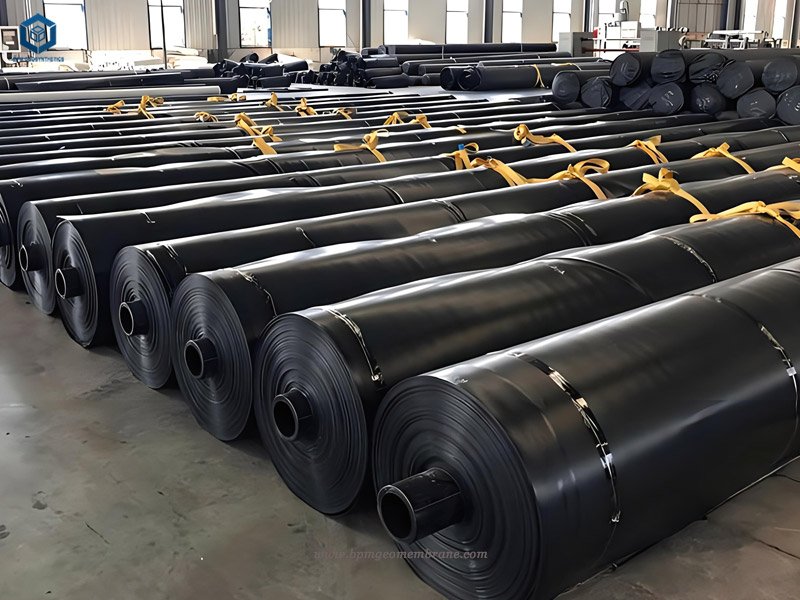
5. Typical Application of HDPE Membrane In Environmental Protection Projects
HDPE membrane is widely used in environmental protection projects. It is mainly used to block harmful substances and protect soil and water bodies through its superior anti-seepage performance and chemical resistance, thereby achieving the goal of environmental protection. The following are some of the main applications of HDPE membrane in environmental protection projects:
5.1 Remediation of Contaminated Sites
Anti-seepage layer: HDPE geomembrane can be used to repair contaminated land and cover the contaminated area as an anti-seepage layer to prevent pollutants from penetrating into the soil and blocking the further spread of harmful substances.
Isolation layer: When treating contaminated sites, HDPE geomembrane can be used as an isolation layer to effectively prevent pollutants from affecting the surrounding environment.
5.2 Landfill Environmental Protection
Anti-seepage layer: HDPE membrane is a commonly used anti-seepage layer material in landfills. It is used to prevent wastewater from penetrating into the soil and reduce the risk of groundwater pollution.
Covering layer: In the final covering layer of the landfill, HDPE geomembrane can effectively isolate garbage, prevent rainwater penetration, and reduce waste discharge.
5.3 Remediation of Oil-polluted Areas
Anti-seepage layer: In oil-polluted areas, HDPE geomembrane can be used as an anti-seepage layer to prevent oil pollutants from penetrating into soil and water and improve the repair effect.
Pollutant interception: HDPE membrane can be used to construct pollutant interception pools to prevent oil pollutants from flowing into water bodies and help control and treat pollution.
5.4 Industrial Wastewater Treatment
Anti-seepage layer: In industrial wastewater treatment facilities, HDPE membrane can be used as an anti-seepage layer to ensure that treated water does not leak into the surrounding soil and groundwater.
Storage tanks and tank linings: HDPE geomembranes can be used to construct storage tanks and tank linings for industrial wastewater to improve the storage efficiency and safety of wastewater.
5.5 Sewage Treatment Plant
Anti-seepage layer and liquid storage tank: HDPE membrane can be used in the anti-seepage layer and liquid storage tank of sewage treatment plants to ensure that the treated water will not pollute the surrounding environment.
Sedimentation tank lining: In the sedimentation tank, HDPE geomembrane can be used as a lining to prevent sediment from seeping into the soil and reduce the impact of solid waste.
5.6 Water Resources Protection and Management
Reservoir and water body restoration: HDPE membrane can be used in reservoir and water body restoration projects as an anti-seepage layer to prevent harmful substances from penetrating into the water body and maintain the quality of water resources.
Water source protection area: In the water source protection area, HDPE geomembrane can be used to prevent pollutants from penetrating into groundwater and protect drinking water sources.
Overall, the application of HDPE geomembrane in environmental protection projects provides effective technical means for treating and repairing contaminated areas, controlling waste discharge, protecting water resources, etc., and helps maintain environmental sustainability.

